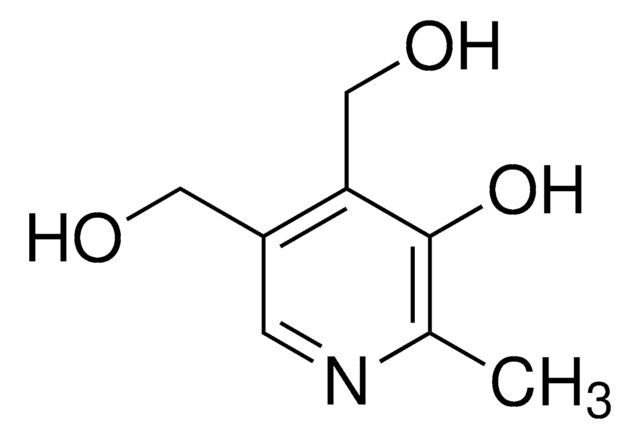T1270
Thiamine hydrochloride
BioReagent, suitable for cell culture, suitable for insect cell culture, suitable for plant cell culture
Synonyme(s) :
Aneurine hydrochloride, Vitamin B1 hydrochloride
About This Item
Produits recommandés
Source biologique
synthetic (organic)
Niveau de qualité
Gamme de produits
BioReagent
Pureté
≥99.0% (HPLC)
Forme
powder
Poids mol.
Mw 337.27 g/mol
Technique(s)
cell culture | insect: suitable
cell culture | mammalian: suitable
cell culture | plant: suitable
Couleur
white
Pf
250 °C (dec.) (lit.)
Solubilité
H2O: 50 mg/mL, clear, colorless
Application(s)
agriculture
Chaîne SMILES
CC1=NC(N)=C(C[N+]2=CSC(CCO)=C2C)C=N1.Cl.[Cl-]
InChI
1S/C12H17N4OS.2ClH/c1-8-11(3-4-17)18-7-16(8)6-10-5-14-9(2)15-12(10)13;;/h5,7,17H,3-4,6H2,1-2H3,(H2,13,14,15);2*1H/q+1;;/p-1
Clé InChI
DPJRMOMPQZCRJU-UHFFFAOYSA-M
Vous recherchez des produits similaires ? Visite Guide de comparaison des produits
Description générale
Application
- of the vitamin-concentrated stock solution for the preparation of Hv-Ca medium for culturing Haloferax volcanii
- of the tris-acetate-phosphate (TAP) medium for culturing Chlamydomonas nivalis
- of modified Bold 3N medium for culturing Chlorella minutissima
Actions biochimiques/physiologiques
Mention d'avertissement
Warning
Mentions de danger
Conseils de prudence
Classification des risques
Eye Irrit. 2
Code de la classe de stockage
11 - Combustible Solids
Classe de danger pour l'eau (WGK)
WGK 1
Point d'éclair (°F)
Not applicable
Point d'éclair (°C)
Not applicable
Équipement de protection individuelle
Eyeshields, Gloves, type N95 (US)
Certificats d'analyse (COA)
Recherchez un Certificats d'analyse (COA) en saisissant le numéro de lot du produit. Les numéros de lot figurent sur l'étiquette du produit après les mots "Lot" ou "Batch".
Déjà en possession de ce produit ?
Retrouvez la documentation relative aux produits que vous avez récemment achetés dans la Bibliothèque de documents.
Les clients ont également consulté
Articles
How thiamine and other cell culture components affect the performance of serum-free, protein-free cell culture systems used for biomanufacturing heterologous proteins including monoclonal antibodies. The page introduces the in vitro chemistry and biochemistry of thiamine.
Neoplastic cells are highly dependent on the de novo synthesis of nucleotides to maintain sufficient pools to support DNA replication and the production of RNA.
Notre équipe de scientifiques dispose d'une expérience dans tous les secteurs de la recherche, notamment en sciences de la vie, science des matériaux, synthèse chimique, chromatographie, analyse et dans de nombreux autres domaines..
Contacter notre Service technique







